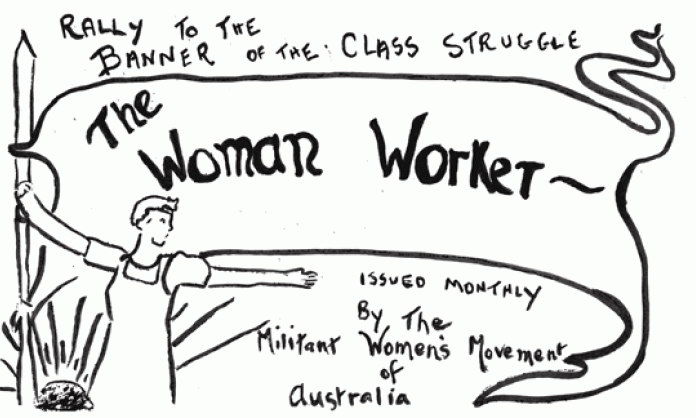Elite champagne breakfasts, corporate lunches and flashy business leadership summits are the events that typically characterise International Women’s Day (IWD) in Australia. So respectable has the day become that a troglodyte like Tony Abbott is able to address a UN breakfast without being howled down.
This is a world away from what the women of the Militant Women’s Movement (MWM) envisioned when they organised the first ever IWD event in Australia in 1928. The aim of their activities, as expressed in their publication Woman Worker, was to bring about the “overthrow of capitalism, the shattering of the whole foundation on which it rests”.
Formed in 1926 by women members of the Communist Party of Australia, the purpose of the MWM was to organise and provide political education to working class women. The inaugural edition of the Woman Worker urged women: “Join the Militant Women’s Movement … to take your part in the bigger fight for the emancipation of the working class.”
Reading the Woman Worker, it is difficult to see the MWM women being welcome guests at most IWD functions today. It ruthlessly mocked the snobbish and condescending attitudes of wealthy women – “rich ‘ladies’, parasites of society with nothing to do” – and shone a light on the daily indignities and humiliations of working class life.
The bitterness was expressed by one reader who in 1929 wrote of the basic wage case: “They ask whether two ties a year are sufficient for a working man, whether a woman of the working class should wear lace on her underclothing … but those living in wealth and idleness flaunt their wealth in our faces.”
The challenges and struggles facing working women, both in Australia and beyond, were the starting point for the MWM. Their pamphlet Women’s Road to Freedom provided detailed information about the conditions under which women work in industry. The Woman Worker contained numerous reports of industrial action by women, including action taken by 400 women workers at the Perdriau rubber factory in 1928 and the 4,000-strong textile workers strike in Melbourne in 1932.
The MWM also recognised the need to organise working class women outside of the workplace, in particular the wives of striking workers. During the major disputes of the late 1920s, including those of timber workers, coal miners, dock and railway workers, the MWM helped to organise women to support the strikes. Far from serving to reinforce their passive position in society, these activities had the explicit aim of politicising the women and drawing them into the struggle.
During the 1929 timber workers’ strike, for example, a Woman Worker report approvingly detailed how the workers’ wives resolved to keep meeting even after their relief work was no longer required: “Because some of the women desire to have them … we have a weekly lecturette and discussion which has been very enjoyable. It is significant that the wives of the timber workers are prepared to come into these meetings although they have to pay their fare. They say they have got used to them and do not want to give them up.”
The MWM unapologetically argued that the broader struggle of the working class for power in society was inseparable from and necessary to achieving women’s liberation, an idea that is all too often disparaged today, or dismissed as “reductionist”, even by some Marxists. They made good use of capitalisation to emphasise this point: “Our slogan for women is: INTO THE CLASS STRUGGLE. We are members of the working class, we are exploited by the master class, we and our children suffer doubly from wage cuts and increased living costs, we are attacked, we must fight – not a sex war but the CLASS WAR. A united front with the men comrades against the boss! A united front for the overthrow of the system!”
Nor did they write long self-pitying columns complaining about sexist stereotypes or treatment and interrogating how it made them feel, as is so common today. They organised to fight and defy these stereotypes against those who benefit from them – the bosses and politicians.
The Woman Worker is filled with stories of women beating up scabs, marching on police stations demanding unemployment relief, campaigning in elections and fighting for better provisions for school children.
One incident in 1930 in the Port of Adelaide involved 100 women chasing scabs after a meeting of a women’s unemployment committee. One woman was reported “jumping on the back” of a scab, “bearing him to the ground, scratching and screaming”.
They also refused to include “household tips” in the Woman Worker, as was customary for women’s publications at the time. “‘The Working Woman’ exists for the purpose of helping all working women to see the necessity to fight for the improvement of the conditions – not to help the boss to further lower their standard and increase his profits”, one article read. “The workers have always been FORCED to economise, but there is no need for them to do it voluntarily and take pride in it.”
Their class politics led them to see domestic life as political, and stereotypes as having an economic function, long before such ideas became accepted in the mainstream.
And they didn’t seem to have the same difficulty in understanding the connection between different forms of injustice and oppression that eludes so many today. The Woman Worker contained frequent reports on the conditions of migrant men and women, along with condemnations of colonial domination. The potential of the working class movement to integrate these issues was illustrated in a small way by a 1931 report on an Unemployed Workers’ Movement meeting in Bankstown.
It described how the crowd responded when one MWM member rose to speak and was heckled for being a woman and a “foreigner” – the crowd turned on the heckler and accused him of being sex-prejudiced, with someone reprimanding: “We want to hear this little woman talk; even though she can’t talk perfect English, she can talk commonsense, and that is more than you can.”
They irreverently challenged every manifestation of class rule, wherever it occurred. In response to the mandatory singing of “God Save the King” and “Advance Australia Fair” in schools, they argued: “These are workers’ children and yet their parents are content to allow this flag flapping to go on … it is ourselves and our children that want saving and … the workers’ advance is what we aim for.”
The women of the MWM, with their insistence that “only the victorious working class, after capitalism is defeated … can and will raise woman to political, economic and social equality with men”, embodied a genuinely radical approach to women’s liberation that we would do well to emulate today.











